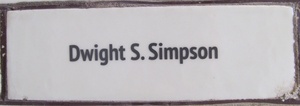Died: 1962
Married:
Children: Mary Elizabeth Carman, Sally E. Svenson, John A. Simpson
Dwight S. Simpson, of Michigan, was a naval architect in Philadelphia who came to Saranac Lake from 1916 - 1919 for the cure.
Mr. Simpson was a partner in the Palmer-Simpson Company, a wartime industry that produced hulls for navy hydroplanes.
The business was centered in Saranac Lake because there were so many guideboat builders there. The firm collapsed when the war ended; Mr. Simpson left Saranac Lake not long afterward.
Mr. Simpson designed a ferryboat, the Roosevelt II, for the Grand Isle Ferry Company on Lake Champlain in 1919, shortly before he left Saranac Lake.
Everyday Engineering, March, 1920
The American Society of Experimental Engineers
WHO'S WHO IN THE A. S. E. E.
 Everyday Engineering, March, 1920DWIGHT SWAIN SIMPSON, M. M. E.—“By Himself”
Everyday Engineering, March, 1920DWIGHT SWAIN SIMPSON, M. M. E.—“By Himself”
The gentleman so austerely pictured is not as old as he looks, having been born in the wilds of Michigan (Muskegon) in the Spring of 1883. The family silver spoon had been mislaid at the time, so he held a kit of tools in his hands.
At an early age he was transplanted to Minnesota and succeeded in reaching the University. Education (so called) was completed at Cornell University, in Mechanical Engineering and the School of Naval Architecture.
During this time every moment that could be stolen from the halls of learning was spent at the lakes and rivers of the wildest parts of the continent. It is his boast that in all the hundreds of miles of wilderness traveled he never cut himself with an axe but once and was lost but once for three days. Not really lost, you know—just didn't know where he was.
Some months in the general shops of a little logging railroad (pattern maker, foundryman, blacksmith, machinist. boiler maker and engineer—all in one for $20.00 per) gave valuable experience that is often called upon to-day.
After escaping from college with the degree of Master of Mechanical Engineering, numerous shipyards were graced by the presence of our hero, serving in any and many capacities, from fitter's helper to chief draftsman. Then a year as consulting engineer and naval architect in Philadelphia drove him back to the quiet of riveting hammers and the shipyards saw him attain.
In 1914, when general manager of the Essington Shipbuilding Co., he retired from active life because of ill health, and until cured by the great war, spent a long time doing nothing.
Then, as head of the newly organ toil firm of Palmer-Simpson Corporation, he began a strenuous two years of struggle against the Hun, the U. S. Navy Department and its inspectors in a more or less successful attempt to build flying boats and seaplanes." A mistake may cost a brave man's life” was the oft-repeated slogan in those days, and although it was necessary to train rnany green men in this new work, no coroner has yet indicted the Palmer-Simpson Corporation.
In a careless moment of his youth this prodigy had his "bumps" felt by a man calling himself a phrenologist, who allowed that the subject could write things. The bump that caused the decision had been made recently by a baseball, but that baseball is a great factor in American life is proved by the fact that some editors have for a long time been good enough to agree with that old fakir and the typewriter has been busy at odd times for many years. Camping, canoeing, woodcraft, yacht building and handling, engineering topics and shop work have been the subjects that from time to time have engaged his literary talents.
In order to have something to write about it was occasionally necessary to do things, and a little shop grew up in the home. As no man is a prophet in his own country, however, the shop was confined to the vicinity of the coal bin or some equally useless place until recently it was moved to a little factory building with the dignity of an office all its own. In its new form "The Experimenter’s Shop” is becoming so well known that we can close this history right here.
To conclude this laudatory sketch we can do no better than to make use of that form which has become so well and widely known during the war.
 A brick at the Saranac Laboratory has been dedicated in the name of Dwight S. Simpson by his daughter, Sally S. Svenson. Nationality—American (four generations on this continent).
A brick at the Saranac Laboratory has been dedicated in the name of Dwight S. Simpson by his daughter, Sally S. Svenson. Nationality—American (four generations on this continent).
Father—Canadian, naturalized.
Mother—American.
Color—White.
Married—Once.
Dependents--Two (wife and small daughter).
Calls himself a naval architect and engineer.
Sings a sort of barytone.
Plays no musical instrument (used to but hasn’t the time). And, like the well-known Rajah of Bong, thinks “He can do almost any old thing."




